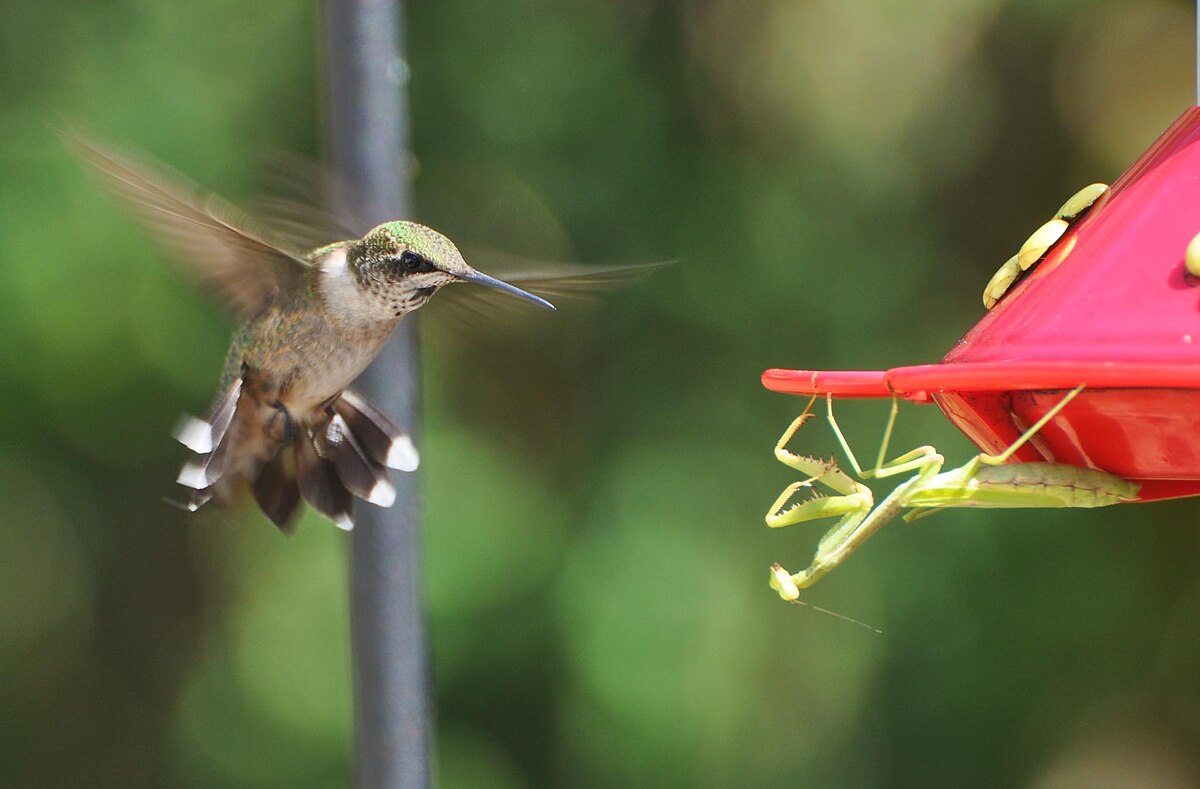Praying mantises are fascinating creatures, known for their unique appearance, swift movements, and predatory habits. With their triangular heads, large eyes, and “prayer-like” posture, they evoke both admiration and curiosity. Most commonly, they are seen preying on insects like flies, moths, and grasshoppers. However, one question that often piques people’s interest is whether these predatory insects are capable of catching and eating larger creatures, such as hummingbirds.
The idea of a praying mantis hunting a tiny, fast-moving hummingbird seems almost too extraordinary to believe. But, in reality, it’s not entirely outside the realm of possibility.
Praying Mantises: Skilled Predators
Praying mantises are ambush predators, meaning they wait patiently for prey to come close before striking with their powerful forelegs. These forelegs are equipped with sharp spines, which help them grab and hold onto their prey once it is within reach. Mantises have an incredible ability to remain still for long periods, blending into their surroundings—whether it’s foliage, flowers, or tall grass—before springing into action.
While their diet primarily consists of insects, mantises have been known to prey on larger animals, including small reptiles, amphibians, and even other mantises. Their hunting technique, combined with sharp mandibles, makes them capable of overpowering prey much larger than themselves.
The Myth of the Praying Mantis and Hummingbirds
There have been occasional reports of praying mantises attacking hummingbirds, particularly in areas where hummingbird populations are abundant. However, such encounters are rare, and while mantises are capable of capturing and eating small animals, there are a number of factors that make it unlikely for them to regularly hunt hummingbirds.
- Size Difference: Hummingbirds are incredibly small, but they are also fast and agile. Their size (typically around 3–5 inches long) and their ability to hover and dart quickly make them a challenging target for most predators, including mantises. Although mantises can catch prey larger than themselves, capturing a quick-moving hummingbird in mid-flight would be difficult.
- Flying Ability: Hummingbirds are exceptional fliers, capable of hovering in one spot and darting in any direction at rapid speeds. They can easily evade potential threats like mantises by zipping away in an instant. This makes it much harder for a mantis, which relies on ambush tactics, to catch a hummingbird in flight.
- Habitat Overlap: Mantises are typically found in gardens, fields, and woodlands, where they wait on plants, flowers, or bushes for prey. Hummingbirds, on the other hand, are most often found in areas with abundant nectar-producing plants and flowers. While there may be some overlap in their habitats, the specific environments where hummingbirds hover are not always ideal hunting grounds for mantises.
When Mantises Do Attack Hummingbirds

There have been documented instances, though rare, of praying mantises attacking hummingbirds. These encounters usually occur when a hummingbird is perched on a branch or flower, resting or feeding. In these situations, a mantis may ambush the bird if it comes within striking range.
In one notable case, a mantis was seen grabbing a hummingbird by its beak and holding onto it with its forelegs. Such attacks typically happen when the mantis is positioned on a flower or branch where the hummingbird is feeding. However, even in these instances, the mantis’s success in overpowering a hummingbird is not guaranteed. Hummingbirds are resilient creatures and can often break free from the mantis’s grasp with a burst of flight.
Are Hummingbirds a Primary Food Source for Mantises?
Despite the occasional attack, hummingbirds are not a regular or primary food source for praying mantises. Mantises primarily hunt insects, which make up the majority of their diet. Their prey usually consists of smaller, slower-moving creatures like flies, moths, and beetles. While mantises may occasionally target larger animals in rare circumstances, such as small reptiles or amphibians, their main focus remains on insects.
Conclusion
In conclusion, while praying mantises have the ability to catch and kill prey larger than themselves, including small birds, the idea that they regularly hunt and eat hummingbirds is largely a myth. Due to the size, speed, and agility of hummingbirds, as well as the mantis’s preference for insects, these two creatures do not frequently cross paths in a predator-prey relationship. Nonetheless, rare instances of mantises attacking hummingbirds do exist, usually when a hummingbird is stationary and within the mantis’s reach.
While such events are fascinating and may seem extraordinary, they are not representative of the typical interactions between mantises and their environment. In the grand scheme of nature, hummingbirds are more likely to face threats from other predators—such as larger birds and mammals—than from a tiny insect like the praying mantis.



